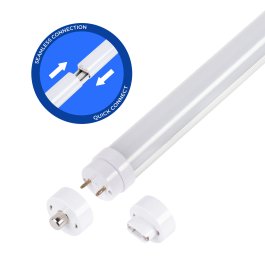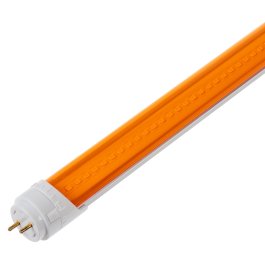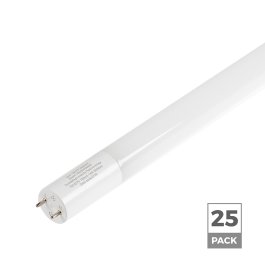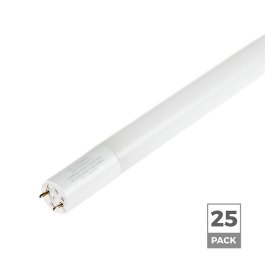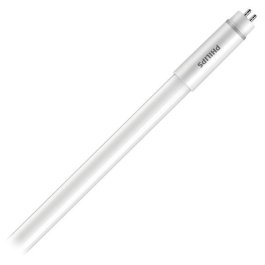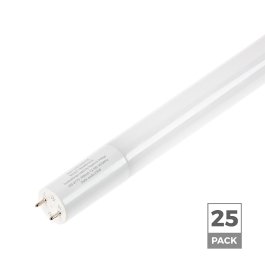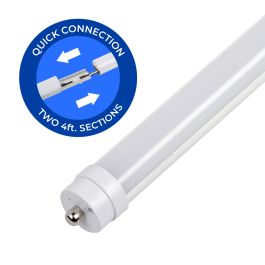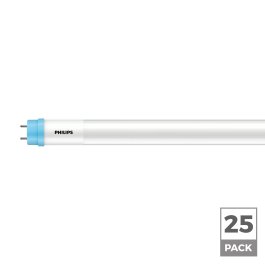LED tube lights are energy-efficient alternatives to traditional fluorescent tubes. They offer significant advantages, such as reduced energy consumption, longer lifespan, and improved lighting quality. They are widely used to retrofit fluorescent fixtures in commercial, industrial, and residential spaces.
Choosing the right type of LED tube light is essential for achieving optimal performance, cost savings, and ease of installation. Both types have distinct advantages, disadvantages, and compatibility considerations, which can significantly impact the retrofitting process and long-term maintenance. By understanding these differences, consumers and professionals can make informed decisions tailored to their specific needs.
What Are Ballast Bypass LED Tube Lights?
Ballast bypass LED tube lights, also called "direct wire LED tubes" or "Type B" tubes, are designed to replace fluorescent tubes by connecting directly to mains voltage. They require the ballast in the fixture to be removed or bypassed, making them a more efficient and low-maintenance option.
These tubes improve efficiency by eliminating energy losses from ballasts and reduce long-term maintenance costs since there is no ballast to fail. However, they require rewiring during installation, which typically needs to be performed by a professional for safety and compliance.
Ballast bypass tubes are ideal for long-term installations in commercial or industrial settings where ballasts are outdated or prone to failure. Their compatibility and performance make them a popular choice for reliable, high-efficiency lighting.
What Are Play-And-Play LED Tube Lights?
Plug-and-play LED tube lights, also known as "ballast compatible" or "Type A" tubes, are designed for easy installation as direct replacements for fluorescent tubes. These tubes work with the existing fluorescent ballast in the fixture, eliminating the need for rewiring.
Their simplicity allows for quick retrofitting projects. However, their performance depends on the compatibility and condition of the existing ballast.
Difference Between Ballast Bypass & Plug-and-Play LED Tube Lights
Both types offer significant energy savings and improved performance over traditional fluorescent tubes, but they differ in installation requirements, compatibility, and maintenance needs. Understanding these differences can help you select the best solution for your specific application.
Installation Differences
Ballast bypass LED tube lights require the ballast to be removed or bypassed, which involves rewiring the fixture. This process is typically handled by a qualified electrician. These tubes are often compatible with non-shunted tombstones, as the electrical connection must pass directly through the fixture to the tube.
There are also universal 3-in-1 tube lights which can be installed as Type B tubes in either single-end or dual-end powered tubes. These tubes are compatible with both shunted and non-shunted tombstones. Universal tube lights are becoming more common over single-end tubes.


Plug-and-play LED tube lights are a direct replacement for fluorescent tubes, requiring no rewiring. They can be easily installed by simply plugging them into the existing fixture, making them a convenient option for DIY projects like residential basements. These tubes work with shunted tombstones because the fixture's ballast remains in place, providing the necessary electrical connections for operation.


Ballast Compatibility
Plug-and-play LED tube lights rely on the existing ballast, so compatibility depends on the ballast type and condition. Ballast bypass LED tube lights operate without a ballast, eliminating concerns about ballast compatibility.
Shunted vs. Non-Shunted Tombstones
Tombstones (also known as lamp holders) are the components that connect the tube light to the electrical circuit within the fixture. The difference between shunted and non-shunted tombstones is in how the electrical current flows through them:
-
Shunted Tombstones: The electrical contacts within the tombstone are internally connected (or "shunted"), meaning the current flows through a single pathway. This design is commonly used in fixtures with instant-start ballasts, where the current is distributed to both ends of the tube simultaneously.
-
Non-Shunted Tombstones: The electrical contacts are not internally connected, providing separate pathways for the current to flow to each end of the tube. This configuration is necessary for tubes that require a specific connection to live and neutral wires, such as ballast bypass tubes or programmed-start ballasts.
The type of tombstone required depends on the LED tube type and its compatibility with the fixture's wiring setup. For example, plug-and-play tubes often work with shunted tombstones, while ballast bypass tubes typically require non-shunted tombstones.


Initial Cost
Ballast bypass LED tube lights typically have a lower upfront price for the tubes but require rewiring, which can result in higher installation costs. In contrast, plug-and-play LED tubes have a higher initial cost but save on installation expenses since they simply plug into the existing fixture without rewiring. The total cost difference depends on whether professional installation is needed and the scale of the project, making it important to weigh short-term expenses against long-term savings.
Maintenance
Ballast bypass LED tube lights eliminate the need for a ballast, reducing the risk of future ballast failures and associated maintenance costs. Plug-and-play LED tube lights depend on the continued functionality of the existing ballast, which may require replacement or maintenance over time if the ballast fails.
Pros and Cons of Ballast Bypass LED Tube Lights
Ballast bypass LED tube lights offer several advantages, making them a popular choice for long-term lighting solutions. They reduce maintenance requirements and the risk of ballast-related failures by eliminating the need for a ballast. These tubes also provide higher efficiency since no energy is lost to the ballast and can work with any T8 or T12 fixture once rewired, offering versatility across various applications.
However, installation is more involved than plug-and-play tubes and can require a licensed electrician.
Pros and Cons of Plug-And-Play LED Tube Lights
Plug-and-play LED tube lights are valued for their simplicity and ease of installation. They require no rewiring and can be directly installed into existing fixtures. This makes them an excellent choice for quick retrofitting projects where minimizing downtime is a priority. Additionally, these tubes maintain the functionality of the existing ballast, providing a seamless and hassle-free replacement.
However, plug-and-play tubes come with some limitations. Their performance and longevity depend on the compatibility and condition of the existing ballast, which may eventually require maintenance or replacement.
Safety Considerations
Ballast bypass LED tube lights require professional installation to avoid electrical hazards from rewiring, while plug-and-play tubes pose minimal risks but depend on the condition and compatibility of the existing ballast for reliable operation.
Suitability for Applications
Ballast bypass LED tube lights are best suited for long-term installations, particularly in fixtures with failing or incompatible ballasts. Their ability to bypass the ballast makes them a durable and low-maintenance option for permanent lighting solutions.
In contrast, plug-and-play LED tube lights are ideal for temporary setups or situations where the existing ballasts are functional and compatible. Their quick installation and ease of use make them a convenient choice for retrofitting projects that prioritize simplicity and minimal downtime.
Ready to Switch to LED Tube Lights?
Choosing between ballast bypass and plug-and-play LED tube lights depends on your needs and long-term goals. By weighing the advantages and limitations of each option, you can ensure your lighting upgrade meets performance and cost-efficiency goals.



